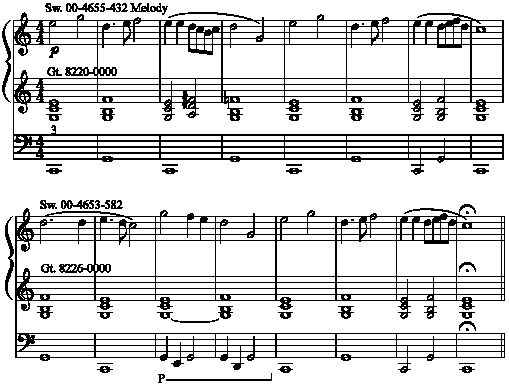
21.1. (11-97) The indications for pedalling, including those for the changing of feet, are treated in the same manner as that already explained for fingering (Paragraph 14.1-14.4.1). When a change of feet is indicated without specifying either toe or heel, the sign K is placed after the note on which the change occurs.
21.2. (11-97) The crossing of one foot in front of the other is indicated by placing the sign @K before the note to be played by the crossing foot. If the crossing is behind, the sign ,K is similarly used.
Example 21.2-1.
.C
^>_?A:L@K<$A%]L _\1:A,KWL\A<K

21.3. When unusual symbols for pedalling are used in the print, the transcriber must devise adequate braille equivalents and insert a clear description of both print and braille signs in the transcription.
21.4. The tabulation of the details of organ registration at the commencement of a piece should follow as far as possible the method used in a good print edition, though the difference between the length of the lines in print and braille will sometimes enforce some readjustments. The following is a typical specimen:
Example 21.4-1.
Prepare:
Gt.: 8 ft. sw. coupled.
Sw.: Stopped diap., clarabella and gamba (or salicional) 8 ft.
Ped.: Bourdon 16 ft. and Bass flute 8 ft.
Gt. to Ped.
21.4.1. (11-97) Directions for manuals combined with registration which occur in the text should be placed between word signs, and directions for manuals only, whether expressed by abbreviations (Gt., G.O., etc.) or by numerals (I, 1, etc.) are preceded by word
21.5. When the suppression of a stop is indicated in the print by the minus sign or some similar device, this is expressed in braille by the sign 9 placed immediately before the name of the stop.
Example 21.5-1.

(It will be noted in the above example that the stops which are not suppressed are separated from the others by a blank space, and that, in any case, numbers must be separated from letters and these latter from each other, in the same way.)
21.6. In facsimile transcriptions, when the pedal and left-hand parts are written on the same print staff, the combined prefix from Table 20 is used for the first measure of the passage and the parts are placed in separate in-accords. The normal left hand prefix is used for succeeding parallels. When the pedal part drops out, if it is not obvious from the music itself, the prefix @> is used once.
Electronic Organs
21.7. On some electronic organs, the variations of tone are produced by a series of drawbars, each controlling one harmonic in a series of eight or nine for each manual according to the particular model of the instrument. The drawbars can be adjusted to different positions giving an equal number of degrees of intensity, and the position of each drawbar is marked by a number. The scheme of registration, therefore, appears as a horizontal line of figures (divided into small groups by dashes or spaces between each group for the convenience of the reader). In braille, this scheme is shown thus:
Example 21.7-1.
#JJ-DFEE-DCB or #JJ #DFEE #DCB
21.7.1. If one or more drawbars are readjusted during the course of the music, the whole group is given with the changed figures underlined. This underlining is shown in braille by the addition of dot 3 in the same cell as the underlined figure:
Example 21.7.1-1.
#JJ-DFEM-OCB or #JJ #DFEM #OCB
21.7.2. If a group contains a smaller number of figures than its normal complement of drawbars, it must be understood that drawbars to the right of the last number remain at zero.
21.8. The manuals are indicated as (a) Swell (sw.) and Great (gt.); (b) Upper (u) and Lower (l); (c) by a circle (sw.) and a square (gt.). The indications in parentheses show the braille equivalents for these markings.
21.9. A further feature of registration is that in some models there is a miniature octave of keys controlling pre-set combinations of drawbars. The lowest key of this octave is a cancelling switch and the others are named and numbered, counting from the left thus: Gt. F(5).
21.10. Some models also contain a device similar to the pianoforte sustaining pedal and the pedalling signs given in Table 20 are used for this purpose.
21.11. The setting out of registration is the same as that described in Par. 21.4-21.5. The following short piece is a typical example:
Example 21.11-1.
Method: Bar-over-Bar
,R4,H3 SW4 #JJ-DFEE-DCB MELODY
,L4,H3 GT4 #HBBJ-JJJJ
,P$AL3 #C
#D4
A .>'>P.PR .:'FQ ;B.$$EDJD O"R^2
_> _(#0 _(+3 _R#0S#%0 _(+*3
^> ^Y ^( ^Y '''''' ^(
E .>'#1-2 ;B.$$EFGE .Y^2
_>'#1-2 _R#0R+3 _(#0
^>'#1-2 ^NR ''''' ^Y
>SW4 #JJ-DFEC-EHB
>GT4 #HBBF-JJJJ
I .>;B.O': .$'EN^2 .R]$ .O"R
_>_(+3 _(#0 _(@C#0 _(+3
^>^( ^Y <C^\$R ^|:R*C
AC .>'#5-8<L<K
_>'#5-8<L<K
^>'#5-8<L<K
